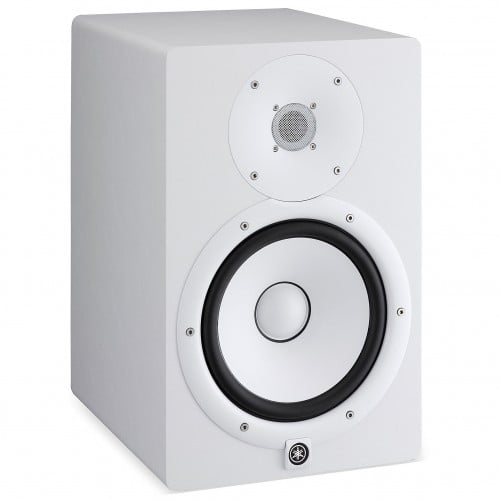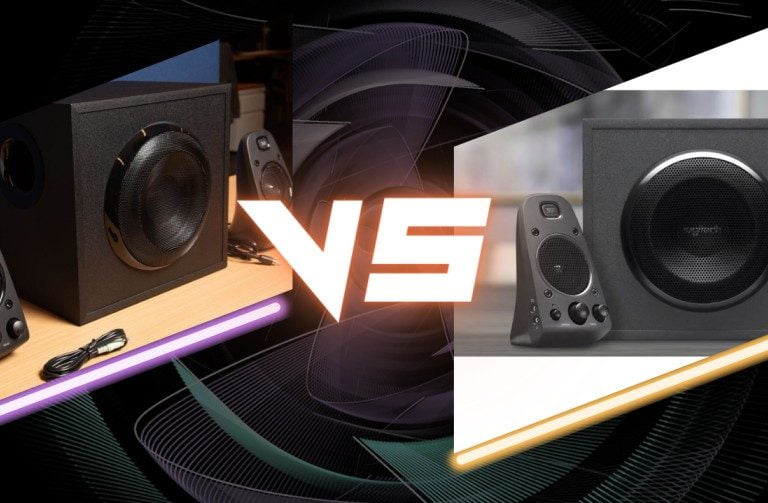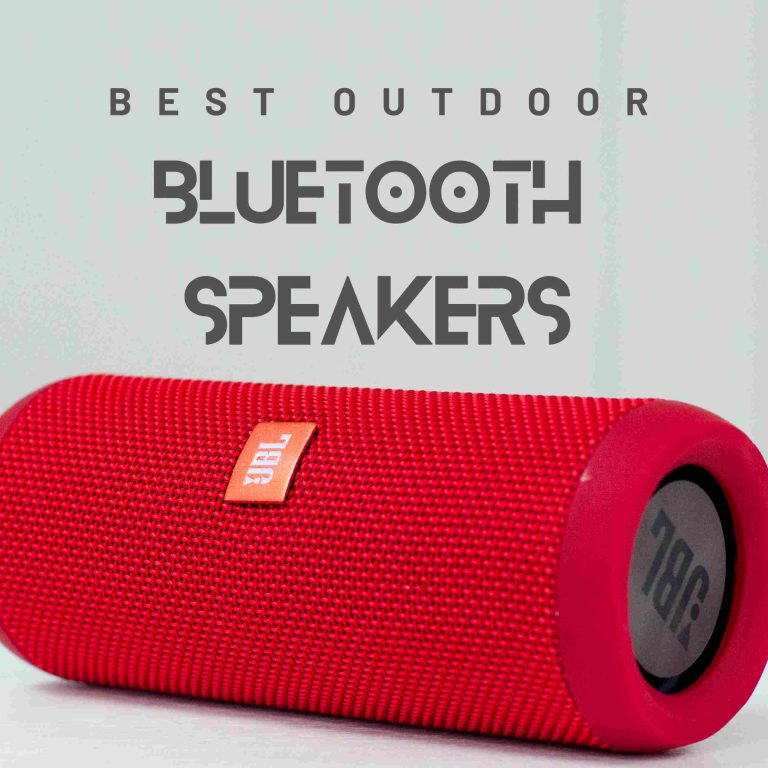Are you a music enthusiast or a professional sound engineer looking to find the best speakers for a studio space? Look no further! We will walk you through the crucial variables to take into account when choosing studio speakers in this in-depth guide, which will improve your audio production experience. Finding the correct speakers is essential for attaining accurate and high-quality sound reproduction, whether you’re setting up a home studio or upgrading your existing setup.
We will provide you all the information you need to make an informed choice, from comprehending the various types of studio speakers to assessing their frequency response and power handling capabilities. Say goodbye to the guesswork and embark on a journey to finding the perfect studio speakers that will bring your music to life. Get ready to take your audio production to the next level with our Studio Speakers guide!
Importance of Speakers for a Studio

Studio speakers play a vital role in the recording process. They are the primary means through which sound engineers and music producers evaluate and make critical decisions about their audio productions. Unlike consumer-grade speakers, studio speakers are designed to provide accurate and uncolored sound reproduction, allowing you to hear every detail and nuance in your recordings. Whether you are mixing, mastering, or simply editing your music, having a reliable set of studio speakers is essential for achieving professional results.
What you hear is what you get when it comes to recording. The accuracy and clarity of your studio monitors can make or break your final mix. With a poor-quality set of speakers, you risk making incorrect decisions about the balance, EQ, and overall sound quality of your recordings. This can lead to a subpar mix and ultimately affect the listener’s experience. On the other hand, investing in high-quality studio speakers ensures that your recordings translate well across different playback systems, providing an immersive and enjoyable listening experience for your audience.
To find the right studio speakers for your recording space, it’s important to understand the different specifications and features that define their performance. Let’s dive into the world of studio speaker specifications and unravel the key factors to consider when choosing the perfect set of speakers for your needs.
Understanding studio speaker specifications

Studio speakers come with a range of specifications that determine their performance capabilities. These specifications include frequency response, power handling, impedance, sensitivity, and more. Understanding these specifications will help you make an informed decision when selecting studio speakers that suit your recording environment and audio production requirements.
Frequency response is one of the most important specifications to consider when choosing studio speakers. It refers to the range of frequencies that a speaker can reproduce accurately. The human hearing range is typically between 20Hz and 20kHz, so it’s crucial to choose speakers that can reproduce this entire range without significant distortion or frequency imbalances. A flat frequency response is desired for accurate sound reproduction, meaning that the speaker doesn’t significantly boost or attenuate certain frequencies.
Power handling is another critical specification to consider. It indicates the amount of power that a speaker can handle without distortion or damage. Higher power handling capabilities allow you to play music at louder volumes without compromising sound quality. It’s important to match the power handling of your speakers with the amplifier or audio interface you’ll be using to drive them. This ensures optimal performance and prevents any potential damage to the speakers.
Impedance refers to the electrical resistance that a speaker presents to the amplifier. It is measured in ohms and determines the load that the amplifier sees. The majority of studio speakers are rated at 4, 6, or 8 ohms in impedance. For effective power transfer and optimum performance, it is crucial to match the output impedance of your amplifier with the impedance of your speakers.
Sensitivity is a specification that indicates how loud a speaker can produce sound for a given amount of input power. It represents the sound pressure level (SPL) at a certain distance when the speaker is operated with a specific power and is expressed in decibels (dB). Higher sensitivity speakers require less power to achieve the same volume level, making them more efficient. The total sound quality isn’t determined by sensitivity alone, thus it’s vital to take into account additional elements as well.
Now that you have a fundamental understanding of the requirements, let’s look at the various studio speaker varieties that are offered on the market.

Types of studio speakers – nearfield, midfield, and main monitors
Studio speakers come in various sizes and designs, each tailored for specific listening distances and room sizes. The three main types of studio speakers are nearfield monitors, midfield monitors, and main monitors. Understanding the characteristics and applications of each type will help you choose the most suitable option for your recording space.
Nearfield monitors are the most common type of studio speakers and are designed to be placed close to the listener or sound engineer. They are typically small in size, ranging from 5 to 8 inches, and are placed on a desk or speaker stands at ear level. Nearfield monitors provide a focused and detailed sound representation, allowing you to hear the subtlest details in your recordings. They are ideal for small to medium-sized rooms and offer a more accurate listening experience compared to consumer-grade speakers.
Midfield monitors, as the name suggests, are designed to be placed at a slightly greater distance from the listener. They are larger in size, ranging from 8 to 10 inches or more, and offer a more extended frequency response and higher volume capabilities compared to nearfield monitors. Midfield monitors are commonly used in larger recording studios or control rooms where accurate monitoring at higher volume levels is required. They provide a balanced representation of the sound without emphasizing any particular frequency range.
Main monitors, also known as farfield monitors, are large-sized speakers designed for spacious control rooms or commercial recording studios. They offer a wide frequency response, high volume capabilities, and are capable of reproducing the full dynamic range of audio recordings. Main monitors are typically used for final mix downs and mastering, where critical listening and accurate sound reproduction are of utmost importance.
Choosing the right type of studio speakers depends on the size of your recording space, the listening distance, and the level of accuracy and detail you require. Now that you are aware of the various types of studio speakers that are available, let’s explore the crucial elements to take into account when picking the ideal pair of speakers for your requirements.
Factors to consider when choosing studio speakers – size, frequency response, and power handling

When selecting studio speakers, several factors need to be considered to ensure that they meet your specific requirements and deliver accurate and high-quality sound reproduction. These factors include speaker size, frequency response, power handling, and more. To assist you in making an informed choice, let’s examine each element in greater detail.
Speaker size
It is an important consideration as it directly affects the frequency response and overall sound reproduction capabilities of the speakers. Smaller speakers, such as 5 to 6-inch drivers, are generally suitable for nearfield monitoring in smaller rooms. They offer good detail and accuracy for close listening distances. The precision and low-frequency response of medium-sized speakers, which range in size from 7 to 8 inches, are balanced, making them appropriate for medium-sized spaces. Larger speakers, such as 10 to 12 inches or more, are better suited for larger control rooms or commercial studios where accurate monitoring at higher volume levels is required.
Frequency response
Frequency response is a critical factor that determines how well a speaker can reproduce different frequencies. The ideal studio speaker should have a flat frequency response, meaning that it reproduces all frequencies equally without any significant boosts or cuts. A flat frequency response allows you to hear the audio content as it was intended, making accurate mixing and mastering decisions. Look for studio speakers that have a wide frequency response and can reproduce both the low and high frequencies with clarity and accuracy.
Power handling
It is an important consideration if you plan to play music at louder volumes without compromising sound quality. A speaker with higher power handling capabilities can handle more power without distortion or damage. Consider the size of your recording space and the volume levels you will be working with to determine the appropriate power handling for your studio speakers. It’s also essential to match the power handling of your speakers with the amplifier or audio interface you’ll be using to drive them.
In addition to these primary factors, it’s also worth considering other features such as connectivity options, built-in amplification, and room correction capabilities. Some studio speakers come with built-in amplifiers, which can simplify your setup and ensure optimal matching between the speakers and the amplifier. Room correction technologies, such as digital signal processing (DSP), can help compensate for acoustic anomalies in your recording space, allowing for more accurate sound reproduction.
We’ll talk about how to set up your studio speakers for the best sound quality in the following part once you have a firm grasp of the crucial elements to take into account when selecting studio speakers.
Setting up studio speakers for optimal sound quality
Setting up your studio speakers correctly is crucial for achieving optimal sound quality and accurate monitoring. Even the highest quality speakers can sound subpar if they are not positioned and calibrated correctly. Follow these guidelines to ensure that your studio speakers are set up for optimal performance:
1. Positioning:
Place your studio speakers on sturdy stands or speaker brackets, ensuring that they are at the appropriate height and distance from your listening position. The tweeters should be at ear level for accurate stereo imaging and soundstage representation. Avoid placing the speakers too close to walls or corners, as this can result in unwanted bass buildup and coloration.
2. Speaker angle:
Position the speakers to form an equilateral triangle with your listening position. It is ideal for there to be an equal distance between each speaker and your position of listening. Listening position. This helps create an accurate stereo image and ensures balanced sound reproduction.
3. Acoustic treatment:
Consider applying acoustic treatment to your recording space to minimize unwanted reflections and improve the overall sound quality. Acoustic panels, bass traps, and diffusers can help tame room resonances and create a more controlled listening environment. Consult with an acoustic specialist or do-it-yourself using available resources to optimize your room acoustics.
4. Calibration:
Use room correction software or hardware to calibrate your studio speakers to your room acoustics. This can help compensate for any frequency response irregularities caused by the room itself, resulting in a more accurate and balanced sound reproduction.
By following these setup guidelines, you can ensure that your studio speakers perform optimally and provide accurate sound reproduction for your audio productions. Now that your studio speakers are all up, let’s examine some of the best manufacturers and models on the market to aid in your decision-making.
Top studio speaker brands and models
When it comes to studio speakers, several brands have established themselves as industry leaders, known for their exceptional sound quality, reliability, and innovative features. Here are some of the top studio speaker brands and models that you should consider when choosing your ideal set of speakers:
1. Genelec

Genelec is renowned for its high-quality, active studio monitors that deliver accurate sound reproduction and exceptional build quality. Their speakers are widely used in professional recording studios and are known for their transparent and detailed sound.
Best Model Right Now:
Genelec G3BW – White – Single
| Brand | Genelec |
| Model Name | G3BW |
| Speaker Type | Subwoofer, Woofer |
| Connectivity Technology | RCA |
| Subwoofer Diameter | 5 Inches |
About this item
- 100 dB
- 55 Hz – 21 kHz (-3 dB)
- Woofer 5 inch + Tweeter 3/4 inch, metal dome + DCW
- Woofer 40 W + Tweeter 40 W
- 1 x RCA analog input, 1 x XLR analog input
2. Yamaha

Yamaha studio monitors have a long-standing reputation for their reliability and accurate sound reproduction. Their range of nearfield and midfield monitors offers a balance of affordability and performance, making them a popular choice among music producers and sound engineers.
Best Model Right Now:
Yamaha HS5 Powered Studio Monitor
| Brand | YAMAHA |
| Model Name | HS5 |
| Speaker Type | Monitor |
| Connectivity Technology | XLR |
| Special Feature | Bass Boost |
About this item
- 2-Way bass-reflex bi-amplified nearfield studio monitor with 5″ cone woofer and 1″ dome tweeter
- 54Hz-30kHz frequency response
- 45W LF plus 25W HF bi-amp system for high-performance 70W power amplification
- Room Control and High TRIM response controls
- XLR and TRS phone jack inputs accept balanced or unbalanced signals
3. Adam Audio

Adam Audio is known for its precise and detailed studio monitors that provide a transparent sound representation. Their speakers feature unique technologies such as the X-ART tweeter, which offers extended frequency response and improved transient response.
Best Model Right Now:
ADAM Audio T5V Studio Monitor Single
| Brand | ADAM Audio |
| Model Name | ADAM Audio T5V Studio Monitor Single |
| Speaker Type | Monitor |
| Connectivity Technology | RCA, XLR |
| Special Feature | Radio |
About this item
- Honest feedback for recording, producing, or mixing – Whether you are creating music, editing your next podcast episode, tracking guitar, or composing for film and video, the revealing nature of ADAM Audio’s signature tweeters and the speaker’s excellent acoustic characteristics ensure a truly referenceable mix you can rely on.
- Quality you can trust for good value– the HPS waveguide in the T5V is the same design that is used in ADAM Audio’s high-end S Series speakers, which allows for more consistent dispersion and more stable imaging over a wider area. The U-ART tweeter design is based on that in the ADAM Audio A and S Series flagship monitors.
- Adjustable to fit your room and your setup – A beveled cabinet with a rear-firing bass reflex port and a small footprint allows placement anywhere in your room, even with limited space. Simple room acoustic adjustments via high- and low-shelf DSP based filters allow for optimal adaptation to acoustically difficult listening environments or individual preferences.
- Easily plug and go – The multi-way analog connections give you the flexibility to integrate various gear outputs so you can start using all of your favorite equipment right away.
- Free plugins upon registration – We’ve partnered with industry favorites to continue providing our community with new tools and discounts. Regularly gain access to new plug-ins by The Plugin Collective when registering any ADAM Audio product in the MyADAM user area.
4. KRK:

KRK studio monitors are popular among music producers and home studio owners for their affordability
and reliable performance. Their speakers are known for their punchy and accurate sound reproduction, making them a suitable choice for various music genres.
Best Model Right Now:
KRK ROKIT103G4 KRK 10″ POWERED MONITOR 300W, Black
| Brand | KRK |
| Model Name | ROKIT103G4 |
| Speaker Type | Monitor |
| Recommended Uses For Product | For Computers |
| Subwoofer Diameter | 10 Inches |
About this item
- High-grade materials equal a great listening experience
5. Neumann:

Neumann is synonymous with quality in the audio industry. Their studio monitors are well-known for having excellent sound quality and paying close attention to detail. Neumann speakers offer a transparent and neutral sound representation, making them ideal for critical listening and professional audio production.
Best Model Right Now:
Neumann KH 120 A – Active Studio Monitor
| Brand | Neumann |
| Model Name | KH 120 |
| Speaker Type | Woofer |
| Connectivity Technology | XLR |
| Recommended Uses For Product | For Music Players |
About this item
- Biamplified (50Watt + 50Watt) 2 way monitoring speaker system featuring a 5.25 inch long throw woofer and 1inch titanium fabric dome tweeter
- Precision manufactured to ± .5db tolerance ensuring perfectly matched pairs to deliver superb sound staging and imaging
- Compact and rugged, non resonant Aluminum enclosure eliminates unwanted cabinet induced coloration
- Free field frequency response of 52 Hertz -21 kiloHertz, ± 3 dB
These are just a few of the top studio speaker brands and models available in the market. It’s important to research and audition different speakers to find the ones that best suit your preferences and budget. Now that you have an idea of the top brands and models, let’s explore some essential accessories that can further enhance your studio speaker setup.
Studio speaker accessories – stands, isolation pads, and acoustic treatment
To maximize the performance of your studio speakers and ensure an optimal listening experience, certain accessories can be beneficial. These accessories help with positioning, isolation, and room acoustics, allowing you to extract the best possible sound quality from your studio speakers. Here are some essential accessories to consider:
1. Speaker stands:
Sturdy speaker stands provide a stable platform for your studio speakers, ensuring that they are positioned at the correct height and angle for accurate sound reproduction. Adjustable stands allow you to fine-tune the speaker position to achieve the optimal listening experience.
2. Isolation pads:
Isolation pads, also known as decoupling pads, help minimize vibrations and resonances that can affect the accuracy of your sound reproduction. Placing isolation pads between your speakers and the stands or desk helps reduce unwanted vibrations, resulting in a more focused and detailed sound.
3. Acoustic treatment:
As mentioned earlier, acoustic treatment plays a significant role in optimizing the sound quality of your recording space. Acoustic panels, bass traps, and diffusers can help control room reflections, minimize flutter echoes, and improve the overall frequency response. Consider incorporating these treatments into your recording space to achieve a more accurate and controlled listening environment.
4. Cable management:
Proper cable management is essential to maintain a clean and organized setup. Use cable ties, cable clips, or cable sleeves to keep your speaker cables tidy and prevent them from interfering with your listening experience.
These add-ons can significantly improve the overall sound quality and listening experience when used in conjunction with your studio speakers. Now that you have everything set up and optimized, let’s discuss some essential maintenance and care tips for prolonging the lifespan of your studio speakers.
Studio speaker maintenance and care

Taking proper care of your studio speakers is essential for their longevity and continued performance. Here are some maintenance and care tips to keep in mind:
1. Cleaning:
Regularly clean the speaker cabinets and grilles using a soft, lint-free cloth. Avoid using harsh chemicals or abrasive materials that can damage the speaker surface. Dust and debris can accumulate on the speaker drivers, affecting sound quality, so periodic cleaning is recommended.
2. Avoid excessive volume:
While it may be tempting to push your speakers to their limits, avoid
To check our more blogs, Click Here




